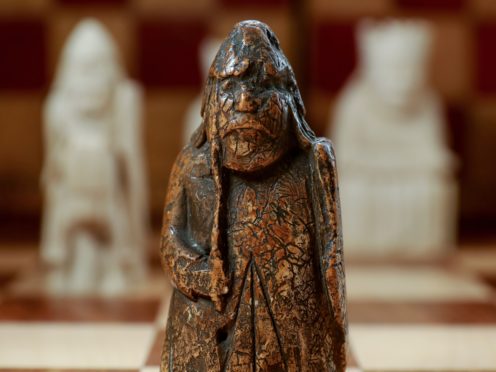A medieval chess piece missing for almost 200 years has sold for £735,000 at auction.
The piece, bought for £5 in 1964 by an antiques dealer and passed down through their family, has hit a new record for a medieval chess piece at auction, Sotheby’s in London has said.
The Lewis Chessmen – a hoard of 93 objects regarded as the most famous chess pieces to have survived from the medieval world – were discovered in 1831 on the Isle of Lewis in the Outer Hebrides.
But the whereabouts of five pieces from the collection have remained a mystery.
A family recently learned that the piece – an 8.8cm warder made from walrus ivory from the late 12th/early 13th century – bought by their grandfather for just £5 more than five decades ago was one of the missing treasures.
The antiques dealer, from Edinburgh, had no idea of the significance of the piece, which has remained in the family ever since.
Having looked after it for 50 years without realising its importance, they took it to Sotheby’s auction house in London.
The Lewis Chessmen are among the biggest draws at the British Museum and the National Museum of Scotland in Edinburgh.
Alexander Kader, Sotheby’s co-worldwide head of European sculpture and works of art, said: “This is one of the most exciting and personal rediscoveries to have been made during my career.
“It has been such a privilege to bring this piece of history to auction, and it has been amazing having him on view at Sotheby’s over the last week – he has been a huge hit. When you hold this characterful warder in your hand or see him in the room, he has real presence.”
Mr Kader, who examined the piece for the family, previously said that his “jaw dropped” when he realised what they had in their possession.
“They brought it in for assessment. That happens every day. Our doors are open for free valuations,” he told PA last month.

“We get called down to the counter and have no idea what we are going to see. More often than not, it’s not worth very much. I said, ‘Oh my goodness, it’s one of the Lewis Chessmen’.”
He said the family, who wish to remain anonymous, were “quite amazed”.
“It’s a little bit bashed up. It has lost its left eye. But that kind of weather-beaten, weary warrior added to its charm,” he said.
The Lewis Chessmen comprise of seated kings and queens, bishops, knights and standing warders and pawns.
Some 82 pieces are now in the British Museum and 11 pieces held by the National Museum of Scotland. As well as the chess pieces, the hoard includes 14 “tablemen” gaming pieces and a buckle.
Since the hoard was uncovered in 1831, one knight and four warders have been missing from the four combined chess sets.
The newly discovered piece is a warder, a man with helmet, shield and sword and the equivalent of a rook on a modern chess board.
The discovery of the hoard remains “shrouded in incredible mystery” even today, with stories of it being dug up by a cow grazing on sandy banks.
It is thought it was buried, possibly by a merchant to avoid taxes after being shipwrecked, shortly after the objects were made and so remained underground for 500 years.
The previous record for a medieval chess piece was set at Sotheby’s in London in 2016, when a piece of a King made in Germany believed to be from 1300-1320, sold for £653,000.
